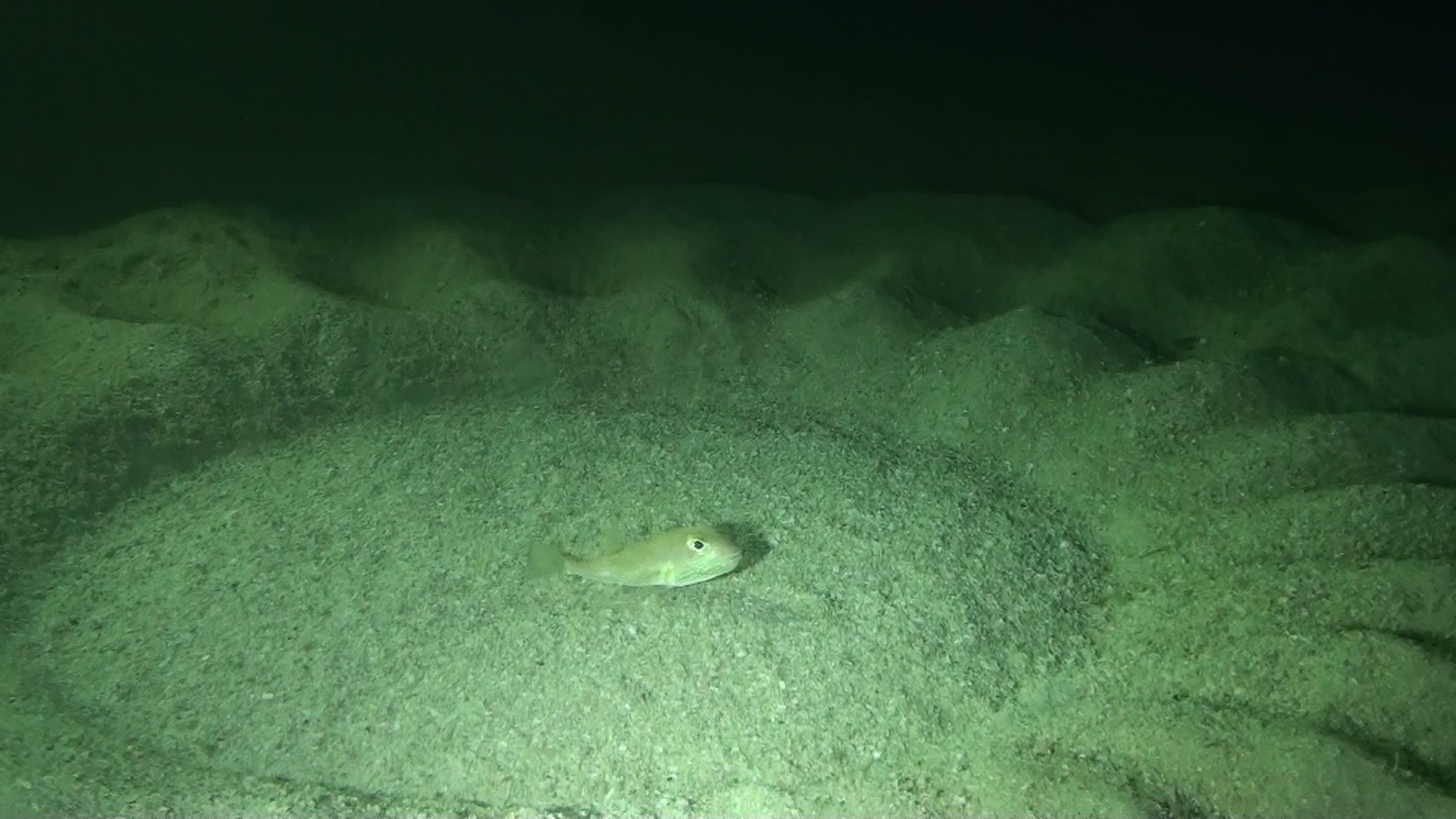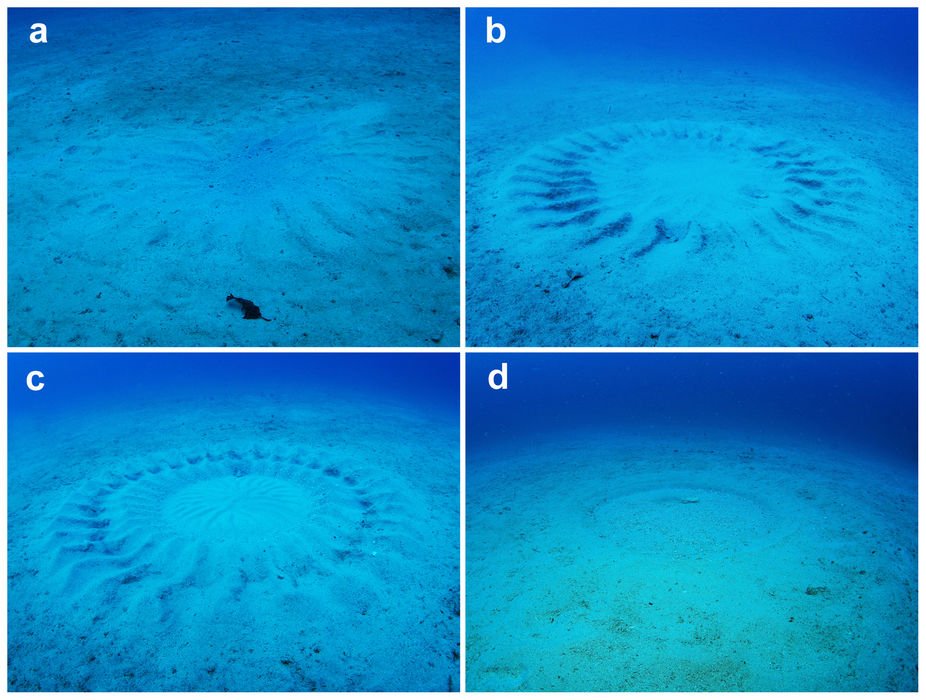Welcome Steemians! Today I want you to take another dive with me somewhere in Japan. Put your diver's suit, mask and snorkel on and let's get into the water.
So, we're swimming and swimming, we come across little fish and take instagram-worthy selfies with our water proof cameras, when we witness this...

(Image source: next.spotlight-media.jp)
We look around and start wondering whether we found traces of the lost Atlantis or signs from the beach holidays of sea-loving aliens. As we stand in awe and surprise, trying to decode the meaning of these patterned circles, we notice a pufferfish (yes, a pufferfish) flapping its fins and furnishing up the details of his work of art.

(Image source: www.decodedscience.org)
The artist with the fins
Although divers first noticed these unusual designs on the seafloor in 1995, it wasn't until 2011 that the artist-to-blame was caught red-handed (or should I say red-finned?) by a researching team from the Coastal Branch of Natural History Museum and Institute in Japan.
In Japan, pufferfish are considered a delicacy, yet they can be potentially poisonous. This particular species, though, is a master in sculpting. Working day and night for almost a week, the male pufferfish uses his fins to create these magnificent, 6-foot (2-meter) in diameter patterns as a preparation for mating. (A guy must know how to create a romantic atmosphere if he wants to get the girl). The male must work quickly if he doesn't want the current to wash away his piece of art and puts a lot of effort to make it on time. He also needs to make his nest as big as possible to make it more noticeable underwater.
Designed to catch the female's attention those circular motives don't serve just as an eye-catcher. They are providing the perfect place for the eggs to hatch. The sand is processed so that the fine parts are used and the shells the male uses to decorate his artistic mating spot also offer nutrients to the hatching grounds. You could agree with me that nature leaves nothing at fate, everything has a very good reason for happening the way it does.
A love-dance on the sand
Although similar male activity has been observed in nature, this pufferfish's mating ritual is really unique. According to Kawase, these fish surround their nesting site with radially aligned ridges and valleys and then decorate them with pieces of shells. They also collect fine sediments to give their final masterpiece a distinctive look and coloring. The center of the circle is left flat because it will host the female's eggs. When the female lays her eggs, she leaves. Then, the male fertilizes them externally and sticks around for almost a week, probably to protect his descendants from lurking dangers.
Let's admire this artist! After studying the dynamics of the male's "sculpting dance", scientists concluded that the fine sediments are gathered by the fish's flapping fins. The upstream portion of the circular mating spot channels water towards the center, where the eggs are laid by the female. The water leaves all fine sediments in the center and then escapes through the downstream peaks and valleys. To put it more simply, the male's movements create a system of peaks and valleys, the water current, when going upwards, deposits fine nutrients to the center. Then, the current goes downwards and gets away through the peaks and valleys of the circle leaving room for the new current to do the same.
Note that the males abandon their circles after reproduction is successful; probably because all nutrients and fine sediments are used up and they have to get a new fertile spot for their next mating round. Below you can view images of the stages before the mating circle is finished and then destroyed by the water currents.

(Image source: nature.com)
While doing my research for this post I could not help but think of how far a man can go for his woman, well basically his children. This pufferfish measures no more than 7 inches (18 centimeters) and works incessantly for 7-9 days to create a 28-square-foot (2.6-square-meter) nest. His nest must be easily distinctive and attracting to the female. Then, the female just lays the eggs and goes away, that's right, she abandons her babies and swims off to somewhere else. The male fertilizes the eggs externally and keeps an eye on them for a few days. If this is not a great example of a loving father, then what is?
Have a look at this video and admire the "dancing" artist as he builds his masterpiece dedicated to love:
References
livescience.com
earthsky.org
decodedscience.org
nature.com
spoon-tamago.com

Thank you for reading my post! I hope you found it fascinating enough to follow me, @ruth-girl, for more exciting phenomena!
If nature's weirdness is your thing, you can check some of the previous articles of this series:
7 - The Mummifying Lake
8 - Ice Fumaroles
9 - Blood Falls
10 - The Lava Lake
11 - The Toxic Underwater Lake
12 - Underwater Crop Circles
13 - The Spotted Lake
Interested in science? Please, don't forget to check the @steemstem project, a community-driven project meant to promote well-written, high-quality, STEM-related content (STEM as for Science, Technology, Engineering and Mathematics). Join them in steemit.chat for more information.
And for those engaging with education, @steemiteducation is here to join all steemian educators in their common cause of making our job easier, more effective and more fun!
Until my next post,
Steem on, people, and keep smiling!


